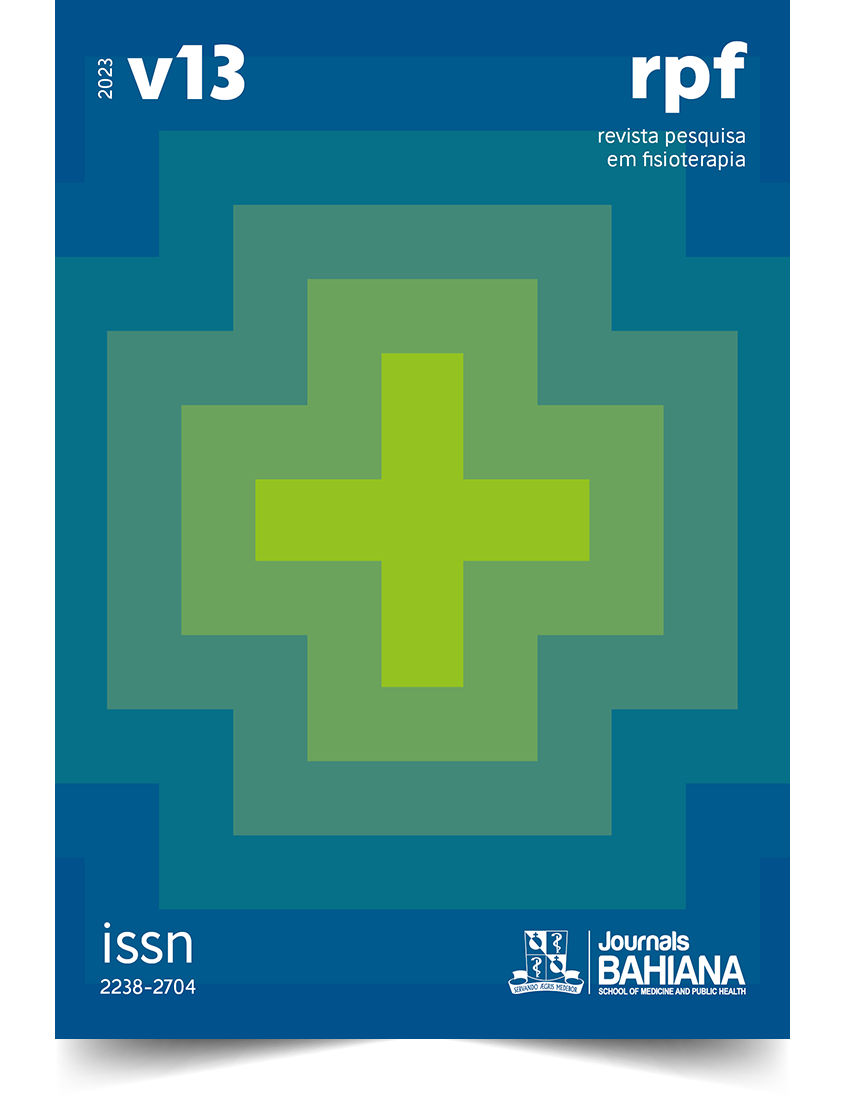Impacto do taping no Tendão de Aquiles nos parâmetros da marcha em indivíduos assintomáticos obesos e acima do peso
DOI:
https://doi.org/10.17267/2238-2704rpf.2023.e4867Palavras-chave:
Tendão de Aquiles, Adulto, Índice de Massa Corporal, Obesidade, SobrepesoResumo
INTRODUÇÃO: O taping do Tendão de Aquiles afeta os parâmetros da marcha em adultos com sobrepeso e obesos? O comprimento dos passos, o comprimento das passadas e a cadência são todos mais curtos nestes indivíduos, com maiores índices queda. OBJETIVO: Saber o efeito do taping do Tendão de Aquiles nos parâmetros de marcha em indivíduos obesos e com sobrepeso. MÉTODOS: Um ensaio clínico será realizado em um ambulatório de fisioterapia. Um total de quarenta participantes com Índice de Massa Corporal (IMC) maior que 25 serão recrutados pelo método de amostragem por conveniência. Cada grupo terá 20 participantes, com idade entre 18 e 35 anos, sobrepeso com IMC>25 a 29,9 e obesidade com IMC>30. Ambos os grupos caminharão por 10 metros e um minuto usando um analisador de marcha, e ambos os grupos terão taping nos Tendões de Aquiles. A variável preditora será o taping do Tendão de Aquiles e as variáveis de resultado serão o comprimento do passo, o comprimento da passada e a cadência, que serão medidos antes e imediatamente após a bandagem. O software SPSS 20.0 será utilizado para análise estatística, com nível de significância de p<0.05. PERSPECTIVAS: A conclusão do ensaio clínico fornecerá informações sobre o impacto da bandagem do Tendão de Aquiles na marcha em indivíduos com sobrepeso ou obesos. Além disso, poderia potencialmente demonstrar que a bandagem pode reduzir o risco de quedas e, assim, impactar positivamente na qualidade de vida.
Downloads
Referências
(1) Lindemann U. Spatiotemporal gait analysis of older persons in clinical practice and research: Which parameters are relevant? Z Gerontol Geriatr. 2020;53(2):171-8. https://doi.org/10.1007/s00391-019-01520-8.
(2) Khokhlova M, Migniot C, Morozov A, Sushkova O, Dipanda A. Normal and pathological gait classification LSTM model. Artif Intell Med. 2019;94:54-66. https://doi.org/10.1016/j.artmed.2018.12.007
(3) Macdonald R. Pocketbook of Taping Techniques. Churchill Livingstone; 2010. 235 p. https://doi.org/10.1016/B978-0-7020-3027-7.X0001-5
(4) Yoon YK, Park JH, Han SH, Lee JW, Park KH. Obesity is an Independent Risk Factor for Achilles Tendon Rupture: A Nationwide Longitudinal Cohort Study in South Korea. Foot Ankle Orthop. 2022;7(1). https://doi.org/10.1177/2473011421S00509
(5) Doral MN, Alam M, Bozkurt M, Turhan E, Atay OA, Donmez G, et al. Functional anatomy of Achilles tendon. Knee Surg Sports Traumatol Arthrosc. 2010;18(5):638-43. https://doi.org/10.1007/S00167-010-1083-7
(6) Laurent D, Walsh L, Muaremi A, Beckmann N, Weber E, Chaperon F, et al. Relationship between tendon structure, stiffness, gait patterns and patient reported outcomes during the early stages of recovery after an Achilles tendon rupture. Sci Rep. 2020;10(1):20757. https://doi.org/10.1038/s41598-020-77691-x
(7) Silsupadol P, Teja K, Lugade V. Reliability and validity of a smartphone-based assessment of gait parameters across walking speed and smartphone locations: Body, bag, belt, hand, and pocket. Gait Posture. 2017; 58:516-22. https://doi.org/10.1016/J.Gaitpost.2017.09.030
(8) World Medical Association. World Medical Association Declaration of Helsinki: ethical principles for medical research involving human subjects. JAMA. 2013;310(20):2191-4. https://doi.org/10.1001/jama.2013.281053
(9) Afzal M, Rizvi F, Azad AH, Rajput AM, Khan A, Tariq N. Effect of demographic characteristics on patient’s satisfaction with health care facility. J Postgrad Med Inst [Internet]. 2014;28(2):154-60. Available from: https://jpmi.org.pk/index.php/jpmi/article/view/1528
(10) Peterson CM, Thomas DM, Blackburn GL, Heymsfield SB. Universal equation for estimating ideal body weight and body weight at any BMI. Am J Clin Nutr. 2016;103(5):1197-203. https://doi.org/10.3945/ajcn.115.121178
(11) Liao R, Moriwaki K, Makihara Y, Muramatsu D, Takemura N, Yagi Y. Health Indicator Estimation by Video-Based Gait Analysis. IEICE Trans Inf & Syst. 2021;E104(10):1678-90. https://doi.org/10.1587/transinf.2020ZDP7502
(12) Maktouf W, Durand S, Boyas S, Pouliquen C, Beaune B. Interactions among obesity and age-related effects on the gait pattern and muscle activity across the ankle joint. Exp Gerontol. 2020;140:111054. https://doi.org/10.1016/j.exger.2020.111054
(13) Rosso V, Agostini V, Takeda R, Tadano S, Gastaldi L. Influence of BMI on Gait Characteristics of Young Adults: 3D Evaluation Using Inertial Sensors. Sensors. 2019;19(19):4221. https://doi.org/10.3390%2Fs19194221
(14) Chhabra M, Prabhakar S, Chouhan DK, Dhillon MS. Technical Note: Three-dimensional Gait Analysis. J Postgrad Med Edu Res. 2021;55(4):188-91. https://doi.org/10.5005/jp-journals-10028-1445
(15) Kirkwood RN, Moreira BS, Vallone MLDC, Mingoti SA, Dias RC, Sampaio RF. Step length appears to be a strong discriminant gait parameter for elderly females highly concerned about falls: a cross-sectional observational study. Physiotherapy. 2011;97(2):126-31. https://doi.org/10.1016/j.physio.2010.08.007
(16) Faul F, Erdfelder E, Lang AG, Buchner A. G*Power 3: A flexible statistical power analysis program for the social, behavioral, and biomedical sciences. Behav Res Methods. 2007;39(2):175-91. https://doi.org/10.3758/bf03193146
(17) Portney LG, Watkins MP. Foundations of Clinical Research: Application to Practice. 3rd. ed. Philadelphia: F. A. Davis Company; 2015. p. 170-71.
(18) Calvert M, Kyte D, Mercieca-Bebber R, Slade A, Chan AW, King MT, et al. Guidelines for Inclusion of Patient-Reported Outcomes in Clinical Trial Protocols: The SPIRIT-PRO Extension. JAMA. 2018;319(5):483-94. https://doi.org/10.1001/jama.2017.21903
(19) Hruby A, Hu FB. The Epidemiology of Obesity: A Big Picture. Pharmacoeconomics. 2015;33(7):673-89. https://doi.org/10.1007/s40273-014-0243-x
(20) Egger AC, Berkowitz MJ. Achilles tendon injuries. Curr Rev Musculoskelet Med. 2017;10(1):72-80. https://doi.org/10.1007/s12178-017-9386-7
(21) Chen SM, Lo SK, Cook J. The effect of rigid taping with tension on mechanical displacement of the skin and change in pain perception. J Sci Med Sport. 2018;21(4):342-6. https://doi.org/10.1016/j.jsams.2017.07.008
(22) Stoffel KK, Nicholls RL, Winata AR, Dempsey AR, Boyle JJW, Lloyd DG. Effect of ankle taping on knee and ankle joint biomechanics in sporting tasks. Med Sci Sports Exerc. 2010;42(11):2089-97. https://doi.org/10.1249/mss.0b013e3181de2e4f
(23) Lerner ZF, Board WJ, Browning RC. Effects of obesity on lower extremity muscle function during walking at two speeds. Gait Posture. 2014;39(3):978-84. https://doi.org/10.1016/j.gaitpost.2013.12.020
Downloads
Publicado
Edição
Seção
Licença
Copyright (c) 2023 Amrita Shrestha, Manu Goyal

Este trabalho está licenciado sob uma licença Creative Commons Attribution 4.0 International License.
Esta obra está licenciada com uma Licença Creative Commons Atribuição 4.0 Internacional.



